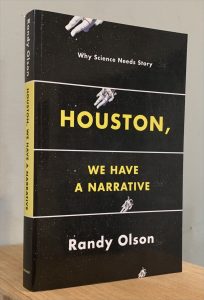 This is an interesting book that I’m disappointed by only because it’s not the book I wanted to read. That is, not the author’s fault. An interesting, useful, book nonetheless.
This is an interesting book that I’m disappointed by only because it’s not the book I wanted to read. That is, not the author’s fault. An interesting, useful, book nonetheless.
(University of Chicago Press, 2015, trade paperback, 260pp)
Olson’s book is about narrative, and science — but only science in terms of writing paper abstracts and press releases. About telling the ‘story’ of new scientific results.
Almost more interesting than the book itself is the Randy Olson‘s background. He was a tenured professor of marine biology until he went to Hollywood and changed careers, directing several documentaries (including Flock of Dodos about the evolution/intelligent design ‘debate’), before becoming a storytelling coach for industry, holder of workshops and writer of guide-book sequels to this one.
(The book that was closer to what I wanted to read was Jonathan Gottschall’s The Storytelling Animal (2012), which I reviewed here about two years ago. It’s all about how narrative is built into human nature, something many others have written about (e.g. Dave McRaney); but it’s not about science.)
Summary:
- He notes that, while scientists invariably, these days, use the ‘IMRAD’ (introduction, method, results, and, discussion) structure for scientific papers, they are poor at communicating these results to the public.
- His solution, to cut to the chase, is Hollywood.
- He reviews the history of stories: Gilgamesh, Aristotle and poetics (prologue, episode, stasimon), and much later Joseph Campbell’s Hero and the common patterns among mythologies and religions of mankind. [[ Getting off track here? Obviously stories told for mythological and religious reasons might be different than stories told for other reasons. ]]
- He’s definitely off track when he claims, with support from a 2009 Nicholas Kristof article, that the ‘programming of the brain is defective’ in its ability to absorb facts. –No, the human brain has become optimized for survival, especially among groups, and doesn’t need to be optimized to absorb facts. That’s why the difficulty between science and the ‘narratives’ that the human brain does readily absorb.
- Eventually he discusses various narrative frameworks. A famous one: thesis, antithesis, synthesis. The entire book is structured this way, in three parts.
- Further down: ABT: And, But, Therefore. The flaws in most scientific abstracts, or even documentaries (like Al Gore’s An Inconvenient Truth), is that they are dry statements of facts. AAA: this AND this AND this AND this. The opposite flaw is over-complication: DHY: this DESPITE this HOWEVER this YET this. The ideal middle optimal narrative form is this AND this BUT this THEREFORE this. Many, many examples.
- And he runs through other templates and models: the Dobzhansky Template, finding a single word or phrase to express your thesis. E.g., “Nothing makes sense in [your field] except in the light of [your claim]. (The famous one is about biology and evolution; similarly about geology and plate tectonics.)
- And others. Focuses on WSP (word/sentence/paragraph) and screenwriting tools like those of Robert McKee: miniplot/archplot/antiplot. The middle is the core of popular movies. And religions. Miniplot is too much complication: DHY.
- And so, why, for example, is global warming boring? Too much miniplot: no clear linear timeline, events ebb and flow, no clear causality, no single protagonist, no closed endings.
- His final “therefore” recommendation is to conduct “story circles” within institutions to meet weekly and refine the stories they should tell to the public.
- [[ He never discusses the narrative structures of fiction. Beginning, middle, end. But of course they align with everything he’s talking about. Most striking is how his idea of “story circles” coincides with the tradition in science fiction of writers’ workshops, where beginning writers meet with senior writers for a week or so to analyze stories, e.g. the Clarion Workshop ]]
- Asides: author knew both Stephen Jay Gould and E.O. Wilson when he was at Harvard, and concludes noting that Gould “was the greatest scientist I ever met.” And yet finishes his book with a sin of Gould’s, in his book THE MISMEASURE OF MAN, in which it turned out he was guilty of confirmation bias, that his thesis in that book was flawed. “[I]t shows that if even the greatest of scientists can fall victim to the narrative programming of the brain, then every scientist needs to be aware of this human weakness and avoid the ways in which it can undermine the scientific process.”
Here, near the very end, is what I wanted to read about. How can science be understood, or perceived, given the human tendency toward the narrative bias?
This book is all about communicating scientific results to the public. What I want to read, or discover, is how science itself can be understood, *despite* the narrative bias. Everyone wants the world to make sense in terms of the narrative bias — cause and effect, reasons and consequences — even though the real world doesn’t seem to operate like that. Quantum mechanics; the origins of the universe; even now the naive folks who, able to see the world only to the horizon, extrapolate that personal experience into imagining the entire world must be as flat as what they see to the horizon.





